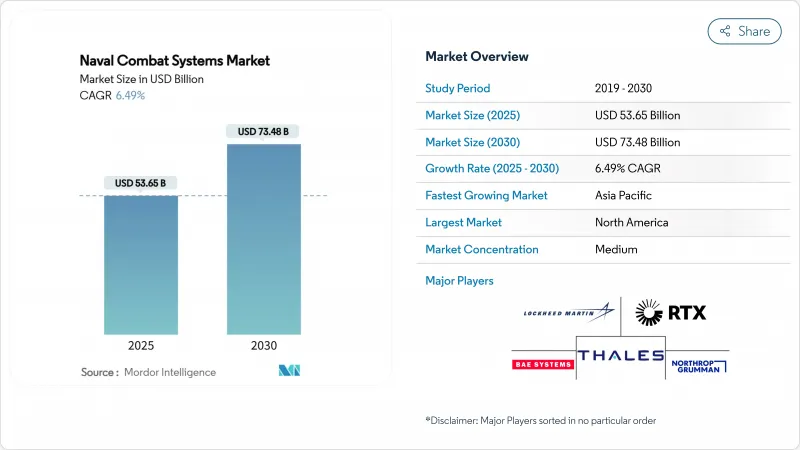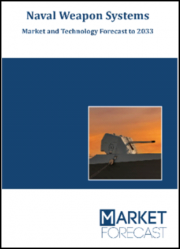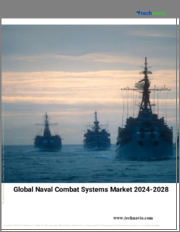
|
시장보고서
상품코드
1836478
해군 전투 시스템 : 시장 점유율 분석, 산업 동향, 통계, 성장 예측(2025-2030년)Naval Combat Systems - Market Share Analysis, Industry Trends & Statistics, Growth Forecasts (2025 - 2030) |
||||||
해군 전투 시스템 시장 규모는 2025년에 536억 5,000만 달러로 평가되고, 2030년에는 734억 8,000만 달러에 이를 것으로 예측되며, CAGR은 6.49%를 나타낼 전망입니다

현재의 확대는 동시 진행하는 함대 근대화 프로그램, 급속하게 성숙하는 지향성 에너지 기술, 임무 컨셉과 승무원 모델을 재구축하는 분산형 무인 해군 아키텍처로의 급속한 이행에 의해 추진되고 있습니다. 통합 전투 관리 제품군에 대한 투자 확대, 전자전과 C4ISR 능력에 대한 수요 증가, DevSecOps 파이프라인의 꾸준한 발전은 모두 장기적인 지출 기세를 강화하고 있습니다. 한편, 무인수상·수중항행체의 획득이 가속됨으로써 해군의 전력구조가 재정의되어 분쟁해역에서의 지속적인 ISR과 저위험 공격 임무가 가능해집니다. 북미의 장점은 미국 해군의 대규모 현대화 예산에 의해 뒷받침됩니다. 그러나 아시아태평양의 성장은 중국의 세 번째 항공모함과 인도, 일본, 한국, 호주의 지역적 대응 조치가 병행한 조달주기에 박차를 가하고 있기 때문에 모든 지역을 능가하고 있습니다.
세계의 해군 전투 시스템 시장 동향과 인사이트
주요 해군의 함대 근대화 계획
세계 함대 업데이트 이니셔티브는 선체 교체 사이클에서 플러그 앤 플레이 전투 스위트를 요구하는 능력 중심 구매로 전환하고 있습니다. 그레이 플래그 2024는 동맹국의 군함이 몇 시간이 아닌 몇 분 안에 조준 데이터를 공유할 수 있도록 하는 공동 소프트웨어 기준선을 검증했습니다. 호주는 2034년까지 수상 전력을 2배 이상으로 증강하겠다고 공약하고 있으며, 프리깃함을 다용한 구성에서 고도의 센서 퓨전을 필요로 하는 분산 편성으로 축족을 옮기고 있습니다. 독일의 2035년 청사진에서는 모듈형 미션 패키지가 강조되어 있으며, 미래의 선체는 최초의 전투 시스템보다 오래 지속되는 것으로 확인되었습니다. 일본 호주와 차세대 프리깃함의 공동 개발은 파트너가 연구 개발을 모으고 취역을 가속화하는 방법을 보여줍니다. 이러한 행동으로 해군 전투 시스템 시장에 안정된 자금이 유입되어 수십년에 걸친 유지 수요가 확보됩니다.
인도 태평양의 지정 학적 긴장 증가
베이징의 항모 '복건'의 배치는 아시아태평양 전역에서 취득 리드 타임을 압축해, 해군이 예정보다 빨리 하드웨어를 실전 투입하는 것을 뒷받침하고 있습니다. 남중국해의 다자간 순찰은 전략적 연합이 종이 업그레이드가 아닌 실시간 능력 교환을 지시하는 방법을 보여줍니다. 수륙 양용 능력은 지역 국가들이 분산 작전에 대비함에 따라 급증하고 통합 방공·공격 패키지에 대한 수요를 높이고 있습니다. 림팩에 있어서의 일본의 항공모함 2척 체제는 장기 전개에 있어서의 전투 시스템의 회복력을 시험하는 출격 템포의 상승을 부조로 하고 있습니다. 방위 산업 협력에 관한 새로운 양자간 포럼은 해군 전투 시스템 시장의 발자취를 확대하는 기술 이전을 제도화합니다.
예산 상한이 표면 전투기 조달을 지연
별자리 프리게이트는 엄격한 예산 프레임워크로 인해 2년 지연되었으며, 동맹국의 공동 생산 프레임워크에 파급되어 공급업체의 현금 흐름 프로파일을 연장하고 있습니다. 프랑스의 플래너는 현재의 함대를 유지하고 호라이즌 구축함의 갱신 자금을 조달하는 사이에 엄격한 트레이드 오프에 직면하고 있습니다. 캔버라의 대규모 조선 계획은 국내 야드의 처리 능력과 수입 서브시스템을 양립시켜야 하며, 일정의 불일치를 초래할 위험이 있습니다. 예산이 늦어지면, 야드는 숙련 노동자의 파이프라인을 유지하는 데 어려움을 겪고, 톤당 비용을 늘리고 해군 전투 시스템 시장에 공급하는 전투 시스템의 구매를 연기합니다.
보고서에서 분석된 기타 성장 촉진요인 및 억제요인
- 통합 전투 관리 스위트의 급속한 보급
- 해군전자전 및 C4ISR 수요 증가
- 무기 통합 인증 사이클 연장
부문 분석
지향성 에너지 무기는 해상에서의 빔 제어 안정성을 검증한 버크급 구축함에서의 HELIOS 증명의 성공에 힘입어 9.63%의 연평균 복합 성장률(CAGR) 예측에서 가장 빠른 궤도를 주장했습니다. 무기 시스템은 2024년 해군 전투 시스템 시장 점유율의 45.65%를 차지했습니다. 이것은 운동 공격에 대한 지속적인 수요를 반영하지만 에너지 무기로의 변절을 인정합니다. 전자전 시스템은 초기 단계의 분쟁에서 전자파에 의한 방해가 지배적이기 때문에 여러 해의 자금 증액을 확보했습니다. C4ISR 패키지도 같은 파도를 타고 우주, 항공, 지상 센서를 연결하는 통합 올 도메인 독린에 밀려 있습니다. 통합된 전투 소프트웨어는 모든 패키지의 축이 되어, 해군은 순찰 사이에 업데이트를 전개할 수 있게 되어, 기동적인 파이프라인의 확장이 가능한 프라임에 있어서 해군 전투 시스템 시장 규모의 우위성을 지키고 있습니다. 무인 해상 시스템의 페이로드 베이에는 지향성 에너지 포탑용 배선이 미리 실시되어 있어, 장래의 고출력 모듈과의 후방 호환성이 확보되고 있습니다. 훈련과 시뮬레이션에 대한 투자는 JF 테일러에 대한 5억 6,300만 달러의 계약에 의해 입증된 대로 속도를 유지합니다.
해군 전투 시스템 시장 보고서는 유형별(무기 시스템, 전자전, C4ISR, 지향성 에너지 무기, 통합 전투 시스템, 무인 해상 시스템 등), 플랫폼별(항공 모함, 구축함, 프리게이트, 코르벳, 잠수함, 연안 전투함 등), 지역별(북미, 유럽 등)으로 분류되어 있습니다. 시장 예측은 금액(달러)으로 제공됩니다.
지역별 분석
북미는 2024년 매출의 37.89%를 차지해 해군 전투 시스템 시장 최대의 지역 공헌자가 되었습니다. 미국 해군의 25년도 예산에서는 이지스함, 차세대 재머, 장거리 수상 드론 프로그램을 위한 수십억 달러의 자금 프레임이 유지되고 2024년에는 49개 선체가 추가되었습니다. HII의 30억 달러 포괄 계약은 이 지역의 서브시스템 공급업체에 대한 풀스루 효과를 증폭시킵니다. 동시에 한국 조선소와의 파트너십은 동맹국으로 능력을 외부화하는 혼합 생산 모델을 시사합니다. 캐나다의 CSC 프리깃함과 멕시코의 OPV 현대화는 달러 기반에서는 여전히 겸손하지만 고객 기반을 넓히고 있습니다. 이 지역 전체에서 프라임은 제로 트러스트 지침을 준수하고 확장되는 해군 전투 시스템 시장을 보호하기 위해 안전한 DevSecOps 파이프라인을 선호합니다.
아시아태평양은 2030년까지 연평균 복합 성장률(CAGR)이 6.71%를 나타내 가장 급성장하고 있는 지역입니다. 복건성 해상 시운전을 계기로 일본, 인도, 한국의 함대 갱신이 가속화되고 있습니다. 각 함대는 현재 연합 임무 중 동맹국의 플러그인을 보장하는 오픈 아키텍처 전투 스위트를 통합하고 있습니다. 호주 수상함대 배증 결정은 '모가미'급을 제공하는 일본 조선소가 적극적으로 요구하는 100억 달러의 기회를 해방합니다. 허드슨 연구소의 보고서에 따르면 일본은 턴키 전투기를 수출하여 미국의 능력 부족을 채울 수 있습니다. 인도가 5척의 함선에 KONGSBERG의 물류 스위트를 채용한 것으로, 스칸디나비아공급자의 리치가 넓어집니다.
유럽은 정책 주도의 꾸준한 성장을 보여줍니다. 베를린의 2035년 해군 계획에서는 F126 프리게이트함의 모듈식 컴뱃 스위트에 자금을 제공해, 선체수보다 소프트웨어의 리프레쉬를 우선시할 예정입니다. 파리는 로마와 호라이즌 구축함의 업그레이드에 공동 출자하여 이불의 레이더 미사일 체인을 강화합니다. 런던의 83형 컨셉은 소프트웨어 중심의 핵심을 지지하는 것, 사이버 하드닝의 표적에 대한 페이스 배분을 고민하고 있습니다. 마드리드와 오슬로는 경쟁 입찰을 통한 CMS 리노베이션을 통해 레거시 터널을 업그레이드합니다. 유럽의 총 예산은 미국 지출보다 낮지만 풀링된 R&D 비용과 표준화된 인터페이스는 수출 지향의 견고한 해군 전투 시스템 시장을 지원합니다.
기타 혜택 :
- 엑셀 형식 시장 예측(ME) 시트
- 3개월의 애널리스트 서포트
목차
제1장 서론
- 조사 전제조건과 시장 정의
- 조사 범위
제2장 조사 방법
제3장 주요 요약
제4장 시장 상황
- 시장 개요
- 시장 성장 촉진요인
- 주요 해군의 함대 근대화 계획
- 인도 태평양 지역의 지정 학적 긴장 증가
- 통합 전투 관리 스위트의 급속한 보급
- 해군전자전(EW) 및 C4ISR 수요 증가
- 분산형 무인 수상/수중 함대로의 변화
- DevSecOps 기반의 "계속적 업그레이드" 아키텍처
- 시장 성장 억제요인
- 예산 상한에 따른 수상 전투기 조달 지연
- 무기 통합 인증 사이클의 연장
- 네트워크 중심의 군함의 사이버 취약성
- GaN 레이더 칩공급 체인 병목
- 밸류체인 분석
- 규제 상황
- 기술적 전망
- Porter's Five Forces 분석
- 신규 참가업체의 위협
- 구매자·소비자의 협상력
- 공급기업의 협상력
- 대체품의 위협
- 경쟁 기업 간 경쟁 관계의 강도
제5장 시장 규모와 성장 예측(금액)
- 유형별
- 무기 시스템
- 전자전(EW)
- C4ISR
- 지향성 에너지 무기(DEW)
- 통합 전투 시스템
- 무인 해상 시스템
- 시뮬레이션 및 훈련 시스템
- 전투 관리 소프트웨어
- 플랫폼별
- 항공모함
- 구축함
- 호위함
- 조계함
- 잠수함
- 연안 전투함(LCS)
- 무인 수상정(USV)
- 무인 잠수정(UUV)
- 기타 플랫폼
- 지역별
- 북미
- 미국
- 캐나다
- 멕시코
- 유럽
- 영국
- 프랑스
- 독일
- 이탈리아
- 스페인
- 기타 유럽
- 아시아태평양
- 중국
- 인도
- 일본
- 호주
- 기타 아시아태평양
- 남미
- 브라질
- 기타 남미
- 중동 및 아프리카
- 중동
- 사우디아라비아
- 이스라엘
- 기타 중동
- 아프리카
- 이집트
- 남아프리카
- 기타 아프리카
- 북미
제6장 경쟁 구도
- 시장 집중도
- 전략적 동향
- 시장 점유율 분석
- 기업 프로파일
- BAE Systems plc
- Lockheed Martin Corporation
- RTX Corporation
- Thales Group
- General Dynamics Mission Systems(General Dynamics Corporation)
- Saab AB
- L3Harris Technologies, Inc.
- Northrop Grumman Corporation
- Elbit Systems Ltd.
- Terma A/S
- Kongsberg Gruppen ASA
- Huntington Ingalls Industries, Inc.
- Leonardo SpA
- ATLAS ELEKTRONIK GmbH
- MBDA
- Naval Group
- Israel Aerospace Industries Ltd.
- Hanwha Systems Co., Ltd.
- Mitsubishi Electric Corporation
제7장 시장 기회와 전망
KTH 25.10.27The naval combat systems market size is valued at USD 53.65 billion in 2025 and is projected to reach USD 73.48 billion in 2030, delivering a 6.49% CAGR.

The current expansion is propelled by simultaneous fleet-modernization programs, fast-maturing directed-energy technologies, and the rapid move toward distributed, unmanned naval architectures that reshape mission concepts and crew models. Growing investment in integrated combat-management suites, rising demand for electronic-warfare and C4ISR capabilities, and steady progress in DevSecOps pipelines all reinforce long-term spending momentum. Meanwhile, accelerated acquisition of unmanned surface and underwater vehicles redefines naval force structure, enabling persistent ISR and low-risk strike missions across contested seas. North American dominance is underpinned by the US Navy's large modernization budget. However, Asia-Pacific's growth outpaces all regions as China's third aircraft carrier and regional counter-moves from India, Japan, South Korea, and Australia spur parallel procurement cycles.
Global Naval Combat Systems Market Trends and Insights
Fleet-modernization programs in major navies
Global fleet-renewal initiatives are moving away from hull-replacement cycles and toward capability-centric buys that demand plug-and-play combat suites. Gray Flag 2024 validated joint software baselines that let allied warships share targeting data in minutes rather than hours. Australia's pledge to more than double its surface force by 2034 drives a pivot from frigate-heavy constructs to distributed formations requiring advanced sensor fusion. Germany's 2035 blueprint stresses modular mission packages, confirming that future hulls will outlive their first combat-system fit. Japan's co-development of next-generation frigates with Australia shows how partners pool R&D to speed entry into service. Together, these actions channel steady funding into the naval combat systems market and ensure multi-decade sustainment demand.
Rising Indo-Pacific Geopolitical Tensions
Beijing's deployment of the carrier Fujian has compressed acquisition lead times across Asia-Pacific, pushing navies to field hardware ahead of schedule. Multilateral patrols in the South China Sea illustrate how operational coalitions dictate real-time capability swaps rather than paper upgrades. Amphibious capacity is surging as regional states prepare for distributed operations, raising demand for integrated air-defence and strike packages. Japan's dual-carrier tasking during RIMPAC underscores an elevated sortie tempo that tests combat-system resilience in prolonged deployments. New bilateral forums on defence industrial cooperation institutionalise technology transfers that expand the naval combat systems market footprint.
Budget Caps Delaying Surface-Combatant Procurement
Tight ceilings have pushed the Constellation frigate two years right, rippling across allied co-production slots and stretching supplier cash-flow profiles. French planners face hard trade-offs between sustaining today's fleet and funding Horizon destroyer renewals. Canberra's massive shipbuilding plan must juggle domestic yard throughput with imported subsystems, risking schedule mismatch. When budgets lag, yards struggle to maintain skilled labor pipelines, raising cost per tonne and deferring combat-system buys that feed the naval combat systems market.
Other drivers and restraints analyzed in the detailed report include:
- Rapid Uptake of Integrated Combat-Management Suites
- Expansion of Naval Electronic-Warfare and C4ISR Demand
- Extended Weapon-Integration Certification Cycles
For complete list of drivers and restraints, kindly check the Table Of Contents.
Segment Analysis
Directed Energy Weapons claimed the fastest trajectory with a 9.63% CAGR forecast, supported by successful HELIOS proofs aboard Burke-class destroyers that validated beam-control stability at sea. Weapon Systems still hold a 45.65% slice of the naval combat systems market share for 2024, reflecting enduring demand for kinetic strike but acknowledging an inflection toward energy arms. Electronic-warfare suites secured multiyear funding upticks because electromagnetic denial dominates early-phase conflict. C4ISR packages ride the same wave, driven by a joint all-domain doctrine that links space, air, and surface sensors. Integrated combat software anchors every package, allowing navies to deploy updates between patrols and protecting the naval combat systems market size advantage for primes able to scale agile pipelines. Unmanned sea-system payload bays are being pre-wired for directed-energy turrets, ensuring backwards compatibility with future high-power modules. Training and simulation investments keep pace, as evidenced by the USD 563 million contract to J.F. Taylor, without which crews could not rehearse complex multi-domain kill chains.
The Naval Combat Systems Market Report is Segmented by Type (Weapon Systems, Electronic Warfare, C4ISR, Directed Energy Weapons, Integrated Combat Systems, Unmanned Sea Systems and More), Platform (Aircraft Carriers, Destroyers, Frigates, Corvettes, Submarines, Littoral Combat Ships, and More), and Geography (North America, Europe, and More). The Market Forecasts are Provided in Terms of Value (USD).
Geography Analysis
North America retained 37.89% of 2024 revenue as the largest regional naval combat systems market contributor. The US Navy's FY25 topline preserved multi-billion funding lines for Aegis, Next Generation Jammer, and the long-range surface drone program that added 49 hulls in 2024. HII's USD 3 billion umbrella contract amplifies the region's pull-through effect on subsystem suppliers. At the same time, partnerships with South Korean yards hint at a blended production model that externalises capacity to allies. Canada's CSC frigate and Mexico's OPV modernization widen the customer base, though still modest in dollar terms. Across the region, primes prioritise secure DevSecOps pipelines to comply with zero-trust directives and protect an expansive naval combat systems market.
Asia-Pacific is the fastest-growing theatre at 6.71% CAGR to 2030. Fujian's sea trials triggered accelerated Japanese, Indian, and Korean fleet renewals; each now embeds open-architecture combat suites to guarantee allied plug-in during coalition missions. Australia's decision to double its surface fleet unleashes a USD 10 billion opportunity actively courted by Japanese yards offering the Mogami-class. The Hudson Institute reports that Japan could fill US capacity gaps by exporting turnkey combatants, a scenario that multiplies subsystem orders anchored in the naval combat systems market. India's adoption of KONGSBERG logistics suites for five ships widens Scandinavian supplier reach.
Europe shows steady, policy-driven growth. Berlin's 2035 naval plan funds modular combat suites for F126 frigates, prioritising software refresh over hull count. Paris co-finances Horizon destroyer upgrades with Rome, reinforcing Franco-Italian radar and missile chains. London's Type 83 concept champions a software-centric core but grapples with pacing against cyber-hardening targets. Madrid and Oslo upgrade legacy tonnage through competitively tendered CMS refits. While aggregated European budgets trail US outlays, pooled R&D and standardised interfaces sustain a robust, export-oriented Naval Combat Systems market.
- BAE Systems plc
- Lockheed Martin Corporation
- RTX Corporation
- Thales Group
- General Dynamics Mission Systems (General Dynamics Corporation)
- Saab AB
- L3Harris Technologies, Inc.
- Northrop Grumman Corporation
- Elbit Systems Ltd.
- Terma A/S
- Kongsberg Gruppen ASA
- Huntington Ingalls Industries, Inc.
- Leonardo S.p.A
- ATLAS ELEKTRONIK GmbH
- MBDA
- Naval Group
- Israel Aerospace Industries Ltd.
- Hanwha Systems Co., Ltd.
- Mitsubishi Electric Corporation
Additional Benefits:
- The market estimate (ME) sheet in Excel format
- 3 months of analyst support
TABLE OF CONTENTS
1 INTRODUCTION
- 1.1 Study Assumptionsand Market Definition
- 1.2 Scope of the Study
2 RESEARCH METHODOLOGY
3 EXECUTIVE SUMMARY
4 MARKET LANDSCAPE
- 4.1 Market Overview
- 4.2 Market Drivers
- 4.2.1 Fleet-modernization programs in major navies
- 4.2.2 Rising Indo-Pacific geopolitical tensions
- 4.2.3 Rapid uptake of integrated combat-management suites
- 4.2.4 Expansion of naval electronic warfare (EW) and C4ISR demand
- 4.2.5 Shift to distributed unmanned surface/underwater fleets
- 4.2.6 DevSecOps-based "continuous upgrade" architectures
- 4.3 Market Restraints
- 4.3.1 Budget caps delaying surface-combatant procurement
- 4.3.2 Extended weapon-integration certification cycles
- 4.3.3 Cyber-vulnerability of network-centric warships
- 4.3.4 GaN radar-chip supply-chain bottlenecks
- 4.4 Value Chain Analysis
- 4.5 Regulatory Landscape
- 4.6 Technological Outlook
- 4.7 Porter's Five Forces Analysis
- 4.7.1 Threat of New Entrants
- 4.7.2 Bargaining Power of Buyers/Consumers
- 4.7.3 Bargaining Power of Suppliers
- 4.7.4 Threat of Substitute Products
- 4.7.5 Intensity of Competitive Rivalry
5 MARKET SIZE AND GROWTH FORECASTS (VALUE)
- 5.1 By Type
- 5.1.1 Weapon Systems
- 5.1.2 Electronic Warfare (EW)
- 5.1.3 C4ISR
- 5.1.4 Directed Energy Weapons (DEW)
- 5.1.5 Integrated Combat Systems
- 5.1.6 Unmanned Sea Systems
- 5.1.7 Simulation and Training Systems
- 5.1.8 Combat-Management Software
- 5.2 By Platform
- 5.2.1 Aircraft Carriers
- 5.2.2 Destroyers
- 5.2.3 Frigates
- 5.2.4 Corvettes
- 5.2.5 Submarines
- 5.2.6 Littoral Combat Ships (LCS)
- 5.2.7 Unmanned Surface Vessels (USV)
- 5.2.8 Unmanned Underwater Vehicles (UUV)
- 5.2.9 Other Platforms
- 5.3 By Geography
- 5.3.1 North America
- 5.3.1.1 United States
- 5.3.1.2 Canada
- 5.3.1.3 Mexico
- 5.3.2 Europe
- 5.3.2.1 United Kingdom
- 5.3.2.2 France
- 5.3.2.3 Germany
- 5.3.2.4 Italy
- 5.3.2.5 Spain
- 5.3.2.6 Rest of Europe
- 5.3.3 Asia-Pacific
- 5.3.3.1 China
- 5.3.3.2 India
- 5.3.3.3 Japan
- 5.3.3.4 Australia
- 5.3.3.5 Rest of Asia-Pacific
- 5.3.4 South America
- 5.3.4.1 Brazil
- 5.3.4.2 Rest of South America
- 5.3.5 Middle East and Africa
- 5.3.5.1 Middle East
- 5.3.5.1.1 Saudi Arabia
- 5.3.5.1.2 Israel
- 5.3.5.1.3 Rest of Middle East
- 5.3.5.2 Africa
- 5.3.5.2.1 Egypt
- 5.3.5.2.2 South Africa
- 5.3.5.2.3 Rest of Africa
- 5.3.1 North America
6 COMPETITIVE LANDSCAPE
- 6.1 Market Concentration
- 6.2 Strategic Moves
- 6.3 Market Share Analysis
- 6.4 Company Profiles (includes Global level Overview, Market level overview, Core Segments, Financials as available, Strategic Information, Market Rank/Share for key companies, Products and Services, and Recent Developments)
- 6.4.1 BAE Systems plc
- 6.4.2 Lockheed Martin Corporation
- 6.4.3 RTX Corporation
- 6.4.4 Thales Group
- 6.4.5 General Dynamics Mission Systems (General Dynamics Corporation)
- 6.4.6 Saab AB
- 6.4.7 L3Harris Technologies, Inc.
- 6.4.8 Northrop Grumman Corporation
- 6.4.9 Elbit Systems Ltd.
- 6.4.10 Terma A/S
- 6.4.11 Kongsberg Gruppen ASA
- 6.4.12 Huntington Ingalls Industries, Inc.
- 6.4.13 Leonardo S.p.A
- 6.4.14 ATLAS ELEKTRONIK GmbH
- 6.4.15 MBDA
- 6.4.16 Naval Group
- 6.4.17 Israel Aerospace Industries Ltd.
- 6.4.18 Hanwha Systems Co., Ltd.
- 6.4.19 Mitsubishi Electric Corporation
7 MARKET OPPORTUNITIES AND FUTURE OUTLOOK
- 7.1 White-space and Unmet-Need Assessment













